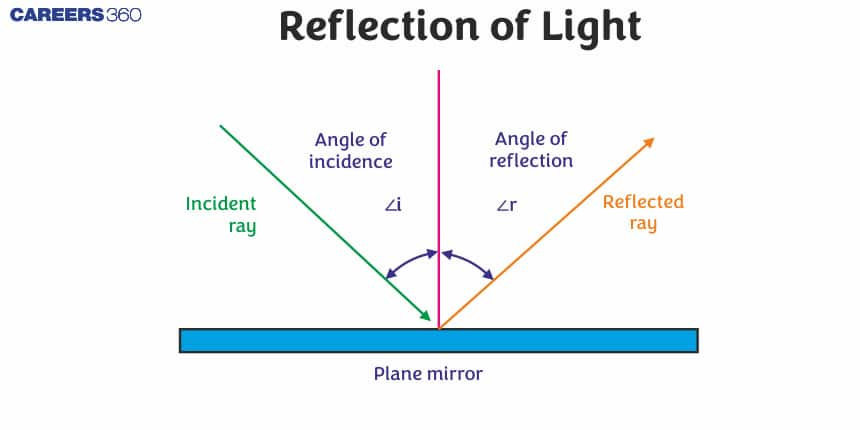Reflection of Light - Definition, Properties, Types, FAQs
Reflection of light happens when light rays bounce back after hitting a smooth, shiny surface like a mirror or calm water. This is why we can see our own image in a plane mirror. A simple example is walking into a dark room you cannot see anything until the light is switched on, then everything becomes visible because of reflection. Reflection follows certain laws, and it can happen in different ways, such as regular, diffuse, or even total internal reflection. These principles are used in many devices like mirrors, optical fibers, periscopes, and cameras. In this article,you will learn about the laws of reflection, types of reflection, total internal reflection and their applications which are important for boards as well as for competitive exams like JEE and NEET.
This Story also Contains
- What is Reflection of Light?
- Laws of Reflection
- Total Internal Reflection
- Properties of Reflection
- Applications of Reflection of Light

Also read -
What is Reflection of Light?
When a ray of light hits the surface, it bounces back from the surface. This bouncing back of light from the surface is called as Reflection of Light.
It is a fundamental concept in optics and necessary for creating images in devices like cameras, telescopes, and eyeglasses. Reflection of light follows the Law of reflection.
Laws of Reflection
- The angle of incidence is equal to the angle of reflection.
This means that the light ray striking the mirror (incident ray) and the light ray bouncing off it (reflected ray) make equal angles with the normal (a line perpendicular to the mirror surface). -
The incident ray, the reflected ray, and the normal all lie in the same plane.
This means that all three of the incoming ray, the outgoing ray, and the normal are on a single flat surface.
Types of Reflection
The reflection is classified as follows:
- Regular Reflection (Specular Reflection):
When light rays fall on a smooth and shiny surface like a mirror or calm water, they are reflected in a single direction. This produces a clear image.
Example: Reflection from a plane mirror.
- Diffuse Reflection (Irregular Reflection):
When light rays fall on a rough or uneven surface like paper, cloth, or walls, the reflected rays scatter in many directions. This type of reflection does not form a clear image.
Example: Reflection from a wall or wooden table.
Multiple Reflection
Multiple reflection occurs when light reflects more than once between two or more surfaces. This happens when the reflecting surfaces are arranged in such a way that the light bounces repeatedly before reaching the observer.
Example 1: A hall of mirrors, where your image appears multiple times due to repeated reflections.
Example 2: Light reflecting between two parallel mirrors, forming several images of an object.
Total Internal Reflection
Total Internal Reflection (TIR) occurs when light tries to move from a denser medium to a rarer medium (like water to air) at an angle greater than the critical angle. Instead of passing into the rarer medium, the light is completely reflected back into the denser medium.
Conditions for TIR:
- Light must travel from a denser medium to a rarer medium.
- The angle of incidence must be greater than the critical angle for the two media.
Examples of TIR:
- Mirages seen on hot roads.
- Optical fibers used in communication.
- Diamond sparkle due to TIR inside the gem.
- Prisms in binoculars and periscopes.
Properties of Reflection
When light reflects from a surface, it shows certain important properties. The angle of incidence is equal to the angle of reflection, and the incident ray, reflected ray, and the normal all lie in the same plane. Reflection can form images that are real or virtual, depending on the surface. Plane mirrors produce upright, virtual, and same-sized images, while curved mirrors can produce both real and virtual images. Light is reversible, meaning it can follow the same path if its direction is reversed. Plane mirrors also cause lateral inversion, which is the left-right reversal of the image.
Applications of Reflection of Light
- Mirrors in Daily Life: Used in bathroom mirrors, dressing mirrors, and vehicle rearview mirrors to see images clearly.
- Periscopes: Submarines and tanks use periscopes to see objects that are not in direct line of sight using plane mirrors.
- Kaleidoscopes: Use multiple plane mirrors to create beautiful symmetrical patterns.
- Optical Instruments: Telescopes, microscopes, and cameras use mirrors to reflect light and form images.
- Decorative Items: Mirrors are used in interiors, walls, and art to enhance brightness and aesthetics.
- Vehicle Safety: Rearview and side mirrors help drivers see vehicles coming from behind.
Frequently Asked Questions (FAQs)
The angle between the reflector and the light rays is 90° , when the light rays is incident conventionally on a plane mirror surface.
This indicates that the angle of incidence between the incident light rays and the normal is 0o.
Because the angle of incidence is 0 degrees, the angle of reflection is also 0o. (Due to the law of light reflection).
Light is an electromagnetic wave that travels as a kind of energy. Light is a kind of energy. Light always travels as a straight line. The propagation of light does not necessitate the use of a medium. It can even travel through a vacuum or air.
The light rays incident on the plane mirror is called the incident ray. The plane mirror reflects the incident ray which is called reflected ray.
The ray which is totally reflected back to the same medium is called the total internal reflection (r> 90o).
Specular reflection
Diffused reflection